by Team Updraft | Nov 4, 2024 | Plugin News, WP Optimize
WP-Optimize version 3.7.0 includes two new exciting optimisation features.
In the free version, you can now automatically preload your content when a page or post is purged or updated. This ensures that your new content is instantly available to visitors, eliminating any potential delays.
If you’re a premium user, you can now identify plugins which cause your site to slow down. With the table usage feature, you have the power to detect plugins which cause slow database queries, giving you the opportunity to replace them with faster alternatives.
Automatic preload feature (free)
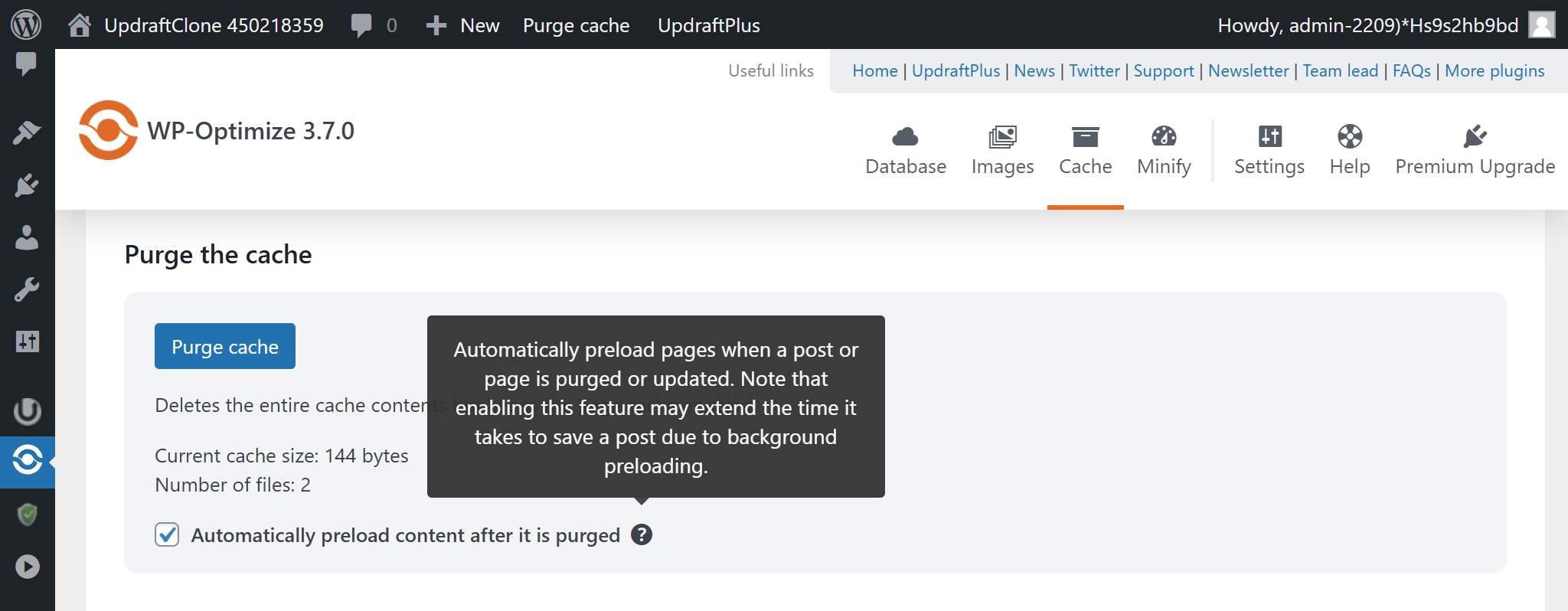
Existing users can enable automatic cache preloading in their settings. This is enabled by default for new users.
- Go to WP-Optimize >> Page cache >> Purge the cache.
- Tick the Automatically preload content after it is purged checkbox.
- Click the Save changes button.
Identify slow plugins feature (exclusive to premium users)
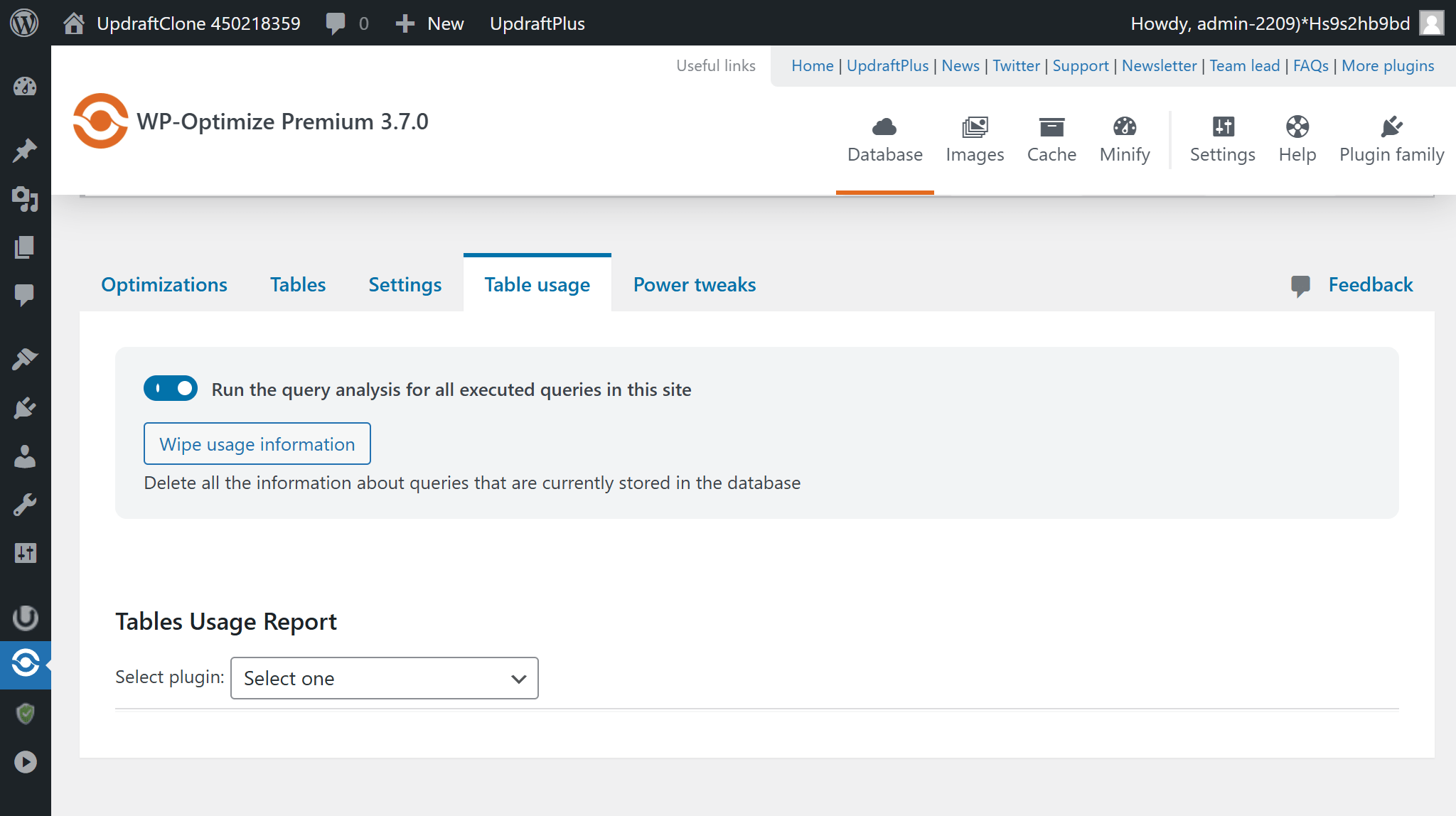
To identify slow plugins:
- Go to WP-Optimize >> Database >> Table usage.
- Click the Run the query analysis for all executed queries in this site.
- Select a plugin in Tables Usage Report to view detailed performance information.
Other improvements
- We’ve fixed an issue with the cache scheduling feature which prevented it functioning properly due the user ID not being set when preloading via CRON.
- We’ve also fixed an inconsistency with the smush_manager_send_command function.
For a full list of changes, please review the changelog below.
Changelog:
* FEATURE: Added an option to automatically preload URLs immediately after cache content is purged.
* FEATURE: Premium – Gather data about table usage by filtering query event.
* FIX: Cache – Scheduled preloading wasn’t working.
* FIX: Inconsistency in smush_manager_send_command function.
* REFACTOR: Smush – Popup styles, remove unused code.
* TWEAK: Fix fatal implode error when updating to v3.5.0.
* TWEAK: Image compression – Issue with cancelling smush image compression.
* TWEAK: Improve module minification logic.
* TWEAK: Premium – Unused images – Fixed popup when moving images to or restoring images from the trash.
* TWEAK: Premium – Unused images – Placeholder images in unused images section.
* TWEAK: Added security.md file with information to report security issues.
by Team Updraft | Nov 4, 2024 | Plugin News, WP Optimize
The new 3.6.0 version of WP-Optimize has arrived. We’ve introduced a new premium feature to auto-detect images that don’t have dimension attributes.
Without the correct dimensions, your web browser has to download the image, calculate its size and then rearrange the page layout. This process slows down page loading and degrades performance, causing increases in Cumulative Layout Shift (CLS) and First Contentful Paint Time (FCP). These are key metrics that Google uses which can affect your page rank.
With this feature enabled, you can significantly boost your PageSpeed insights score by having the image dimensions readily available in the HTML markup.
Image dimensions feature (exclusive to premium users)
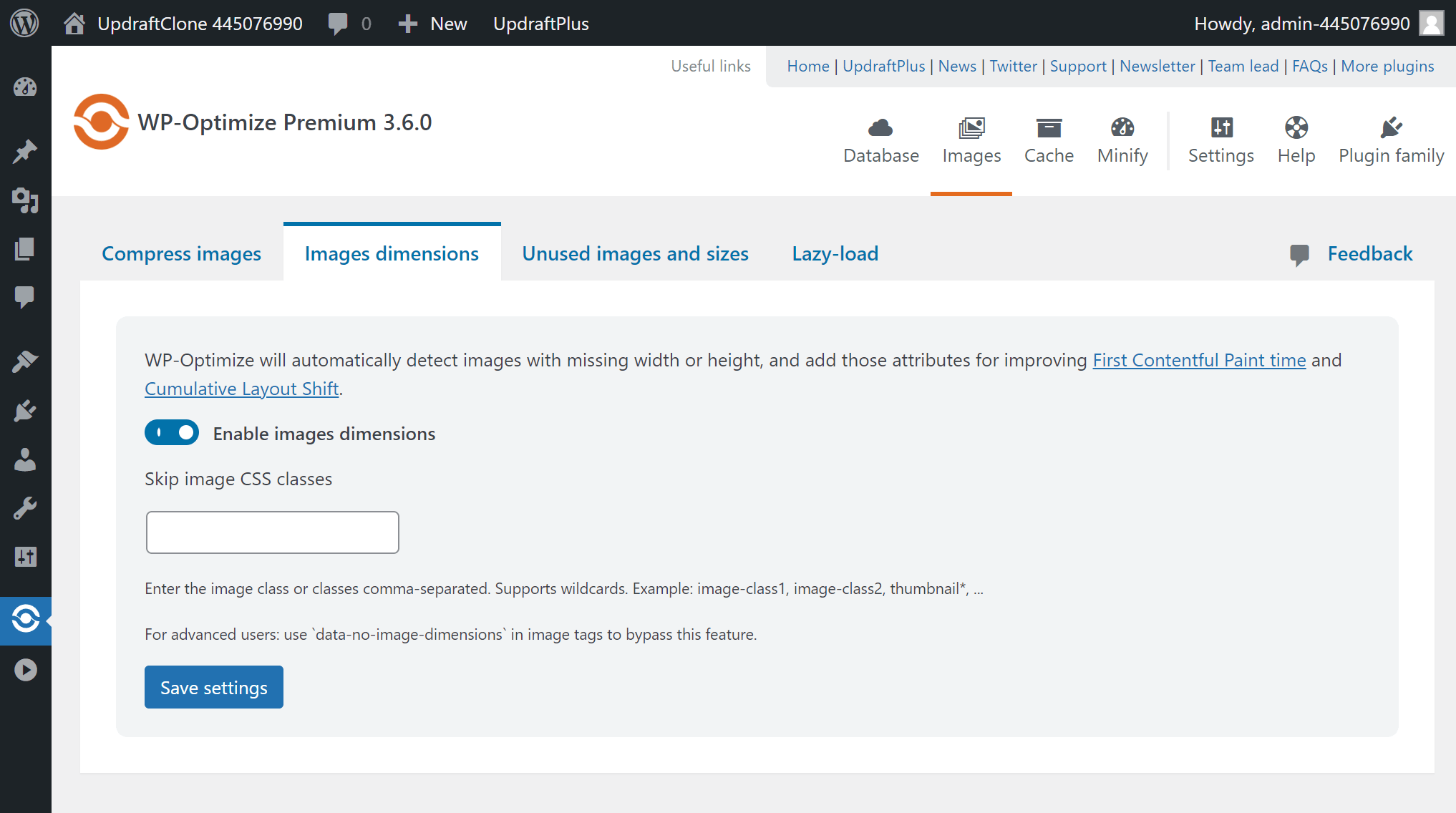
To quickly add dimensions to your images:
- Go to WP-Optimize >> Images >> Images dimensions
- Click the Enable images dimensions button
- Click the Save settings button
That’s all there is to it.
Other improvements (free and premium)
- We’ve enhanced the WebP conversion feature to ensure it remains active, even if only one shell command is detected.
- We’ve also fixed an issue with the Unused Image Size feature which prevented images from being deleted when outside of the default folder structure (yyyy/mm).
For a full list of changes, please review the changelog below.
Changelog:
* FEATURE: Premium – Auto-detect images lacking dimension attributes and add them to improve CLS.
* FIX: Fixed the issue that disabled WebP conversion due to checking all shell commands for WebP compression.
* FIX: Premium – Unused Images – The unused image size deletion functionality does not work when images are not in the /yyyy/mm/ folder.
* REFACTOR: Removed unnecessary static methods in WebP class.
* TWEAK – Image compression – Rolled back to using popup error notices as in versions prior to 3.4.0.
* TWEAK: Added a more descriptive error with resolution proposals for failed gzip compression and browser cache tests.
* TWEAK: Fix broken unused image list thumbnails and download as csv link in Multisite.
* TWEAK: Fix the singleton pattern in Heartbeat class.
* TWEAK: Image compression functionality added to the Media Library page.
* TWEAK: Premium – Cache – Added support for Aelia Currency Switcher plugin.
* TWEAK: Premium – Unused images – improve clarity in UI for images in post revisions.
by Mandy Kayat | Jul 16, 2024 | optimize images, Plugin News, WP Optimize
In this release we’ve added loads of new features and tweaks.
We’ve made some major improvements to image optimization. Premium users now have the ability to perform bulk image compression and restoration directly from the WordPress media library. In the past, this was only possible in the images tab. With this update, you can selectively restore multiple images or compress them in bulk, making it easier to manage your media files. We’ve also added a new filter in the media library that allows you to filter images by their compression status.
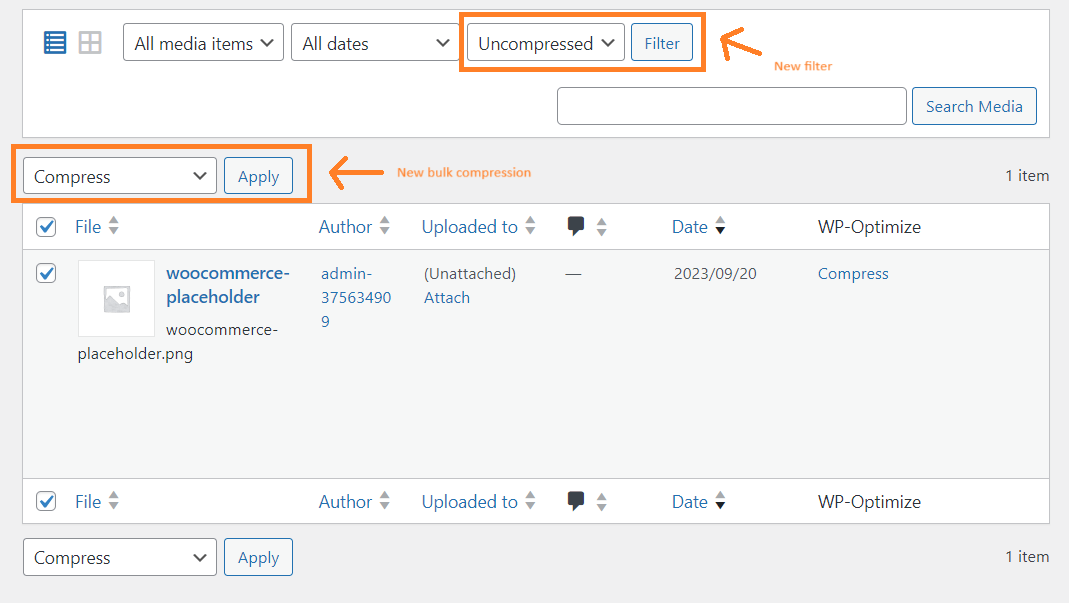
Free and premium users can also automatically delete old images when new scaled versions are created. WP-Optimize will use the scaled images instead of the original ones, saving disk space.
And you can now control how WebP images are served. Previously, the plugin automatically chose between .htaccess redirects and HTML alteration methods for WebP files based on your server type. With the new ‘wpo_force_webp_serve_using_altered_html’ filter hook, users can force WP-Optimize to use the HTML alteration method. This can help you avoid compatibility issues on certain hosting environments.
We’ve also made some general tweaks and updates. We will no longer minify CSS/JS files that are already minified by WordPress core or other plugins/themes to save on processing time. We also made sure that WP-Optimize is compatible with WordPress’s new script loading strategies.
Additionally, we updated the old codebase to use HeartBeat API instead of Ajax calls. HeartBeat API is built into WordPress and provides a more standard way for communication between the WordPress server and the browser. This change will help to reduce your server load and speed up your site. For sites that don’t use HeartBeat, we’ve included backups to keep things running smoothly.
We’ve added compatibility with the Curcy WooCommerce multi-currency plugin, which lets you easily manage different currencies on your e-commerce site.
Lastly, we’ve made several UI improvements for a better user experience.
For the full list of changes, please review the changelog below.
Changelog:
* FEATURE: Premium – Smush – Bulk compress / restore from media library
* FIX: Deactivate the form for minifying JS/CSS settings when the corresponding option is disabled
* REFACTOR: The functionality for the ‘Unused Images’ feature in ACF has been moved to a separate class
* TWEAK: Add UpdraftCentral commands for the latest WP-Optimize features
* TWEAK: Adjusted the scheduled preload time for improved performance
* TWEAK: Auto-update advanced-cache.php settings during site migration
* TWEAK: Cache – Human-readable file names for the cache directory
* TWEAK: Caching related cron jobs are activated even though cache is disabled
* TWEAK: Image compression – Updated message for restoring images action
* TWEAK: Implement Heartbeat API for image compression progress updates
* TWEAK: Improving vendor autoload
* TWEAK: Introduces a hook (`wpo_force_webp_serve_using_altered_html`) for changing WebP serving method
* TWEAK: Minify – Exclude .min files from minification
* TWEAK: Minify – Improve list of processed files UI
* TWEAK: Optimization of the get_uncompressed_image query
* TWEAK: Persist script loading strategy when minifying JS files
* TWEAK: Premium – Compatibility with Curcy WooCommerce multi currency plugin
* TWEAK: Premium – Unused Images – Added an option to delete original images when scaled versions exist
by wpoadmin | Aug 29, 2022 | WP Optimize
Next-day interim update: Now that our main developer with responsibility for this area of the code has been able to get out of bed (he is in a different time-zone) and conducted an initial analysis, things look quite different. The controversy is entirely mistaken, and would not have existed if we had been consulted in any of our available support channels (e.g. the open-to-everyone forum on wordpress.org) and allowed sufficient time to investigate before publication (we first became aware at the end of a Monday that was a UK public holiday). In fact, on the analysis that we have now had time to perform, the controversy originated with a direct competitor who, after misconfiguring the plugin (what he configured is not a default option, and could only be achieved by either overlooking or misunderstanding the described use-cases and entering contrary details into the settings field), subsequently used the resulting Twitter storm to promote his own competing products. Fuller details will be forthcoming once our investigations are complete.
* * *
In the last hour I have been made aware of some code in WP-Optimize’s “minify” module whose actual purpose (whether legitimate, or whether just to “cheat” page-speed-measurement tools) is questionable. We are investigating this, and a statement has been posted here whilst we carry that investigation out: https://wordpress.org/support/topic/code-under-investigate-in-wp-optimize/.
For clarity, we:
- definitely do not approve of such “cheats”
- will remove the code immediately after our investigation if it is found to be such
- and as explained at that link, inherited that particular section of code from another open-source minification project under an open-source licence, and did not at the time notice its suspect characteristics which we have now become aware of.
As stated at the above link, there is no question of the code being dangerous, vulnerable or useful for hackers – the question is whether it does anything useful to optimise your website for real-world visitors, or is just there to get better scores on speed measurement tools. Our products’ integrity and customers’ trust is essential for us, and we will take appropriate action as soon as our investigation is completed.
David Anderson (on behalf of WP-Optimize / Team Updraft)
by dnutbourne | Jun 10, 2022 | WP Optimize
With all the different image formats available for your WordPress site, it can be a little confusing when deciding which one is the right option. While most users have stuck to the tried and tested PNG or JPEG formats, a revolutionary new image format called WebP is now available.
WebP provides superior lossless and lossy compression for any images you add to your WordPress site. By using WebP, WordPress users can create image files that are not just smaller, but also allow your site to run and load faster.
When comparing WebP to other popular image upload format options, we can see how much of an improvement can be achieved by switching to this new format:
How does WebP Work?
If you upload an image using WebP, its lossy compression algorithm uses predictive coding when encoding the image. In using this predictive coding, it uses the values of the block of pixels next to each other to predict the value of the block and encode only the difference. For more detail of the compression technique, please check out this link.
WebP in WP-Optimize
While there may be existing plugins already on the WordPress market that enable you to upload in the WebP format, WP-Optimize uses a different process that is not only much quicker, but also much easier to carry out. With other plugins, you have to go through the complicated process of having to select the converter (to convert from JPEG/PNG to WebP) and the method to serve the WebP files. With the WP-Optimize WebP upload method, we offer a simple one click solution. So when users select the WebP format for their images, conversion can be done there and then automatically when uploading or compressing images.
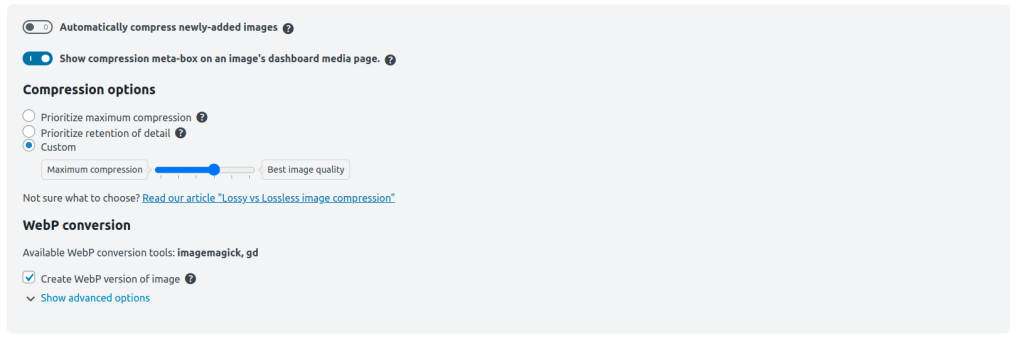
Conclusion
Given how important the loading speed of your site is for your SEO score, WordPress users cannot afford to miss out on the big savings that can be made by using the WebP format with WP-Optimize. Download and install WP-Optimize today to start using this feature and improving your WordPress site.
by Wayne Mullins | Dec 1, 2021 | WP Optimize, WP-Optimise
The latest update for WP-Optimize 3.2.1 has now been released. As you can see from the list below we have been hard at work making changes, and as such – this latest update comes with a huge number of tweaks and fixes. As part of the new update, we have made changes so that WP-Optimize helps improve the performance and user experience in some very important areas of your WordPress site, including caching, image compression and minifying.
Try out he new and updated version of WP-Optimize today and see the difference.
- FIX: Apply different image compression levels
- FIX: Cache – Purge WooCommerce product page after stock update
- FIX: Database errors after adding a new site
- FIX: Flatsome theme compatibility with google fonts
- FIX: Image compression advanced settings, display default backup days instead of empty value.
- FIX: Image compression was not working when the image extension used capital letters
- FIX: Premium – Cache – Potential PHP error in User-specific cache
- FIX: Premium – resolve potential admin-area PHP error if the deprecated mailchimp sync plugin and MC4WP plugin are both active (and potentially other situations where a plugin deactivates another)
- FIX: Premium – Unused images – compatibility with PHP 8
- FIX: Premium – Unused images – issue with parenthesis in name
- FIX: Premium – Unused images – Pagination count doesn’t update
- FIX: Prevent a PHP notice when using with UpdraftCentral
- FIX: Save prioritize maximum compression setting correctly
- FIX: Wrong redirect when wiping settings on multisite
- TWEAK: Premium – add review link at bottom of settings
- TWEAK: Force monolog/monolog and psr/log versions to retain PHP 5.X compatibility/satisfy wordpress.org SVN hooks
- TWEAK: Add compatibility with Kinsta
- TWEAK: Added functionality for to convert MyISAM to InnoDB
- TWEAK: Add filters for minify input string
- TWEAK: Cache – Added filter to modify cache exception urls
- TWEAK: Cache – Optimize preload from sitemap
- TWEAK: Cache – Serve different versions based on cookie consent
- TWEAK: changed filter to prevent deprecation notice in php 8.1+
- TWEAK: Decide automatically whether to inline css or not based on file size
- TWEAK: Fix typo in text domain name
- TWEAK: get_hurl function minified.
- TWEAK: Improve clarity of debug message when DONOTCACHEPAGE constant is used
- TWEAK: Improve DB UI/UX on multisite
- TWEAK: Improve minify cache size messages
- TWEAK: Making Estatik plugin compatible
- TWEAK: Minify – Add JS translations support
- TWEAK: Minify HTML only on cache pre-loading
- TWEAK: Port from previous semaphore classes to Updraft_Semaphore_3_0
- TWEAK: Premium – Unused images – Show that there are images in the trash without having to re-scan everything
- TWEAK: Prevent a PHP notice when downloading image compression log file. Fix backup modal styling issue.
- TWEAK: Prevent fatal error in gzip settings when stylesheet could not be fetched
- TWEAK: Short-circuit trivial case of nothing in the buffer when page-caching, to involve any possible other issues
- TWEAK: Update comments count after trackbacks and pingbacks deletion
- TWEAK: Update minified asset when the enqueued scripts and styles version change
- TWEAK: Use proper constant of includes path in user cache extension





Recent Comments